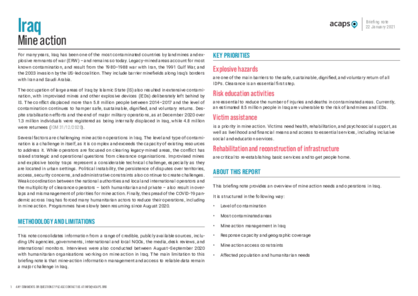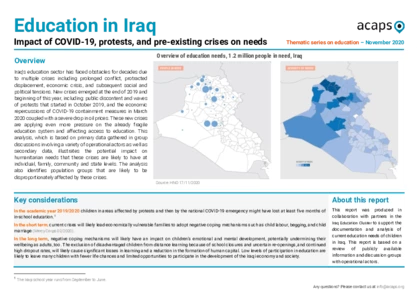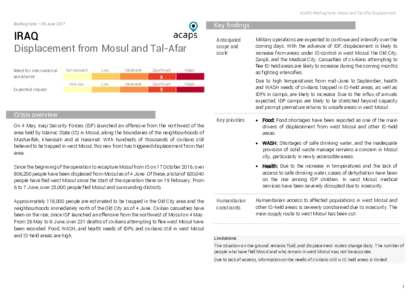Latest updates on country situation
29 November 2023
Drought continues to affect southern Iraq, impacting people’s livelihoods and displacing over 83,500 as at mid-June 2023. The drought is resulting in increased river salinity and land degradation, reducing agricultural products and affecting the fishing industries. More than 60% of 1,000 farmers surveyed in Anbar, Kirkuk, Ninewa, and Salah Al-Din provinces also reported reduced cultivation and water usage in July–August. About 15% of women had lost their income by August 2023 because of the drought, compared to 6% throughout 2022. Food availability has decreased, increasing prices and making food items less affordable for people. Affected families likely need food, water, and livelihood assistance. (NRC 26/11/2023, USAID 30/09/2023, The New Arab 26/11/2023)
16 August 2023
In 2023, water reserves in Iraq are at their lowest in history, with only 7 billion m3 compared to 60 billion m3 in 2020, affecting humanitarian conditions such as people’s livelihoods, food security, health, and WASH. Drought has led farming communities to resort to negative coping mechanisms, with water scarcity affecting labour demand, income generation, and food production. Coping mechanisms include purchasing food on credit, spending savings, and selling productive assets. The stress water scarcity has put on WASH services contribute to deteriorating water quality and hygiene practices in the country, increasing the likelihood of waterborne disease outbreaks and dependency on expensive water trucking and bottled water. In 2022 alone, water scarcity and drought effects displaced 51,000 people. Climate migration often results in people’s exclusion from public services and institutions, the loss of social network, and challenges in obtaining livelihood means and opportunities. (Rudaw 07/08/2023, NRC 15/12/2021, IDMC accessed 16/08/2023)
18 April 2023
On 18 April 2023, the Iraqi Government closed the Jeddah 5 IDP camp in Ninewa Governorate, forcing the 342 families (1,566 residents, almost two thirds of whom are children) to leave the camp. The closure is part of a government plan that began in 2019 to close all IDP camps in the country. Jeddah 5 was one of the last two remaining IDP camps in areas under the control of the Iraqi Federal Government.
Both the residents and humanitarian responders in the camp were only notified two days in advance. In previous camp closures, the majority of IDPs returned to their homes, but almost half live in inadequate conditions.
There are currently around 1.2 million people internally displaced in Iraq, with the vast majority living in host communities in Dahuk, Erbil, Kirkuk, Ninewa, and Sulaymaniyah governorates.
IDPs' most urgent needs include healthcare, food, livelihoods, shelter, and protection. (iDMC 19/05/2022, UN Iraq 19/04/2023, RUDAW 19/04/2023, (DTM accessed 22/03/2023)
22 March 2023
1.2 million people are currently internally displaced in Iraq. More than 70% of the IDPs live in Ninewa, Dahuk, Erbil, Sulaymaniyah, and Kirkuk governorates, with the vast majority living in host communities. The IDPs' most urgent needs include healthcare, food, livelihoods, and shelter assistance.
(Save the Children 20/03/2023, DTM accessed 22/03/2023, RI 20/03/2023)
current crises
in
Iraq
These crises have been identified through the INFORM Severity Index, a tool for measuring and comparing the severity of humanitarian crises globally.
IRQ002 - Internal displacement
Last updated 27/11/2025
Drivers
Conflict/ Violence
Political/economic crisis
Crisis level
Country
Severity level
3.4 High
Access constraints
4.0
Analysis products
on
Iraq
22 January 2021
Iraq: Mine Action
DOCUMENT / PDF / 665 KB
This briefing note provides an overview of mine action needs and operations in Iraq. It consolidates information from a range of credible, publicly available sources, including UN agencies, governments, international and local NGOs, the media, desk reviews, and international monitors.
20 November 2020
Iraq: The return to Sinjar
DOCUMENT / PDF / 383 KB
In October 2020, the federal Government of Iraq and the Kurdistan Regional Government signed an agreement on the status of Sinjar district, in Ninewa governorate. As there is an upward trend in the number of returnees to Sinjar district, this analysis aims to help inform the humanitarian community about the current and expected living conditions and humanitarian needs of both residents and returnees.
09 November 2020
Iraq: Impact of COVID-19 on Education
DOCUMENT / PDF / 896 KB
This analysis illustrates the potential impact on humanitarian needs that ongoing crises in Iraq are likely to have at the individual, family, community, and state levels. The analysis also identifies population groups that are likely to be disproportionately affected by these crises.
07 December 2018
Iraq: Floods in Ninewa and Salah al-Din
DOCUMENT / PDF / 433 KB
Torrential rainfall on 22 and 23 November caused severe flooding across Iraq. Ninewa and Salah al-Din are the most affected governorates with bridges and roads damaged and villages inundated with water. In total, at least 22,000 people in Ninewa governorate and 10,000 people in Salah al-Din governorate are affected, including people still displaced from conflict.
09 June 2017
Iraq: Displacement from Mosul and Tal-Afar
DOCUMENT / PDF / 326 KB
Since the beginning of the operation to recapture Mosul from IS on 17 October 2016, over 806,200 people have been displaced from Mosul as of 4 June. Of these, a total of 630,040 people have fled west Mosul since the start of the operation there on 19 February. From 6 to 7 June, over 25,000 people fled Mosul and surrounding districts.






